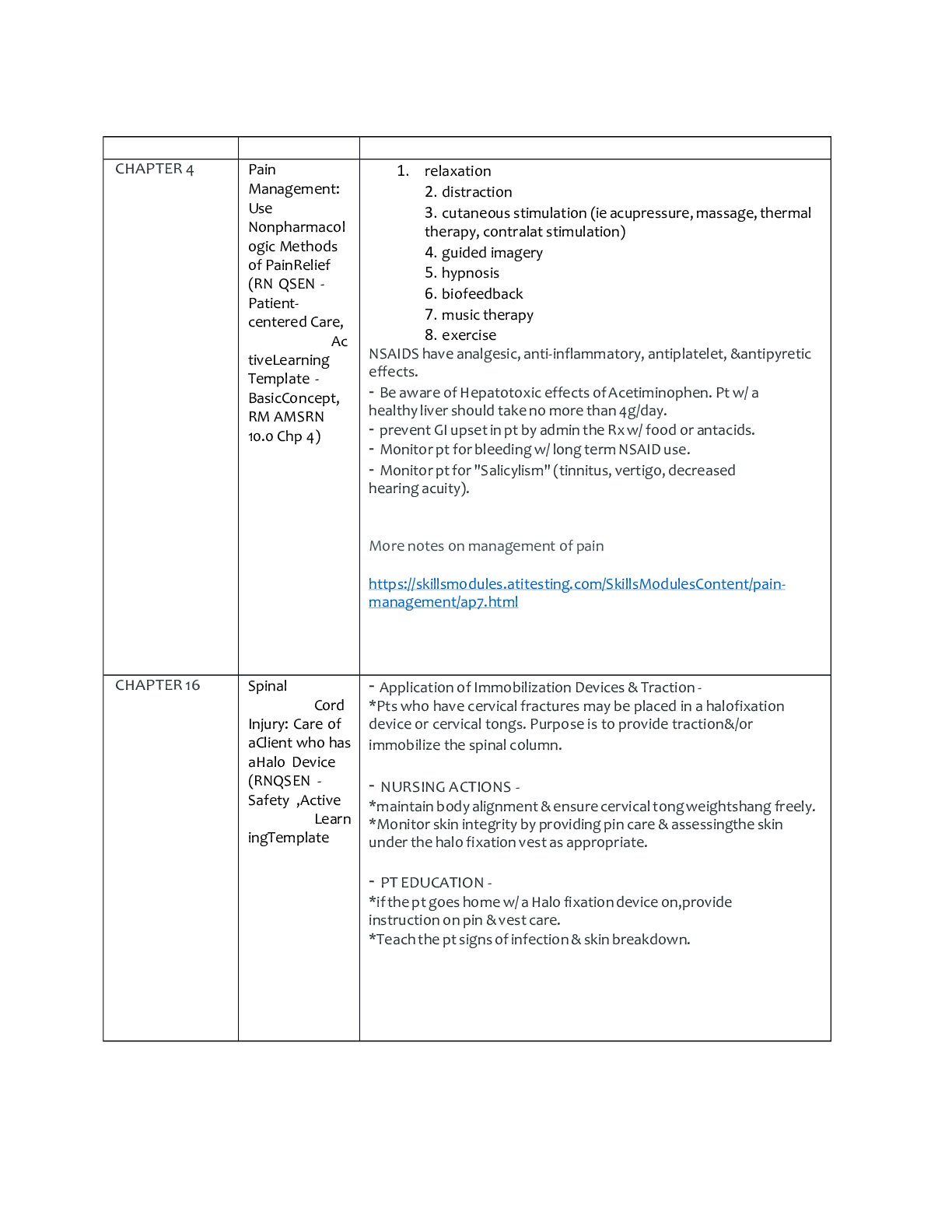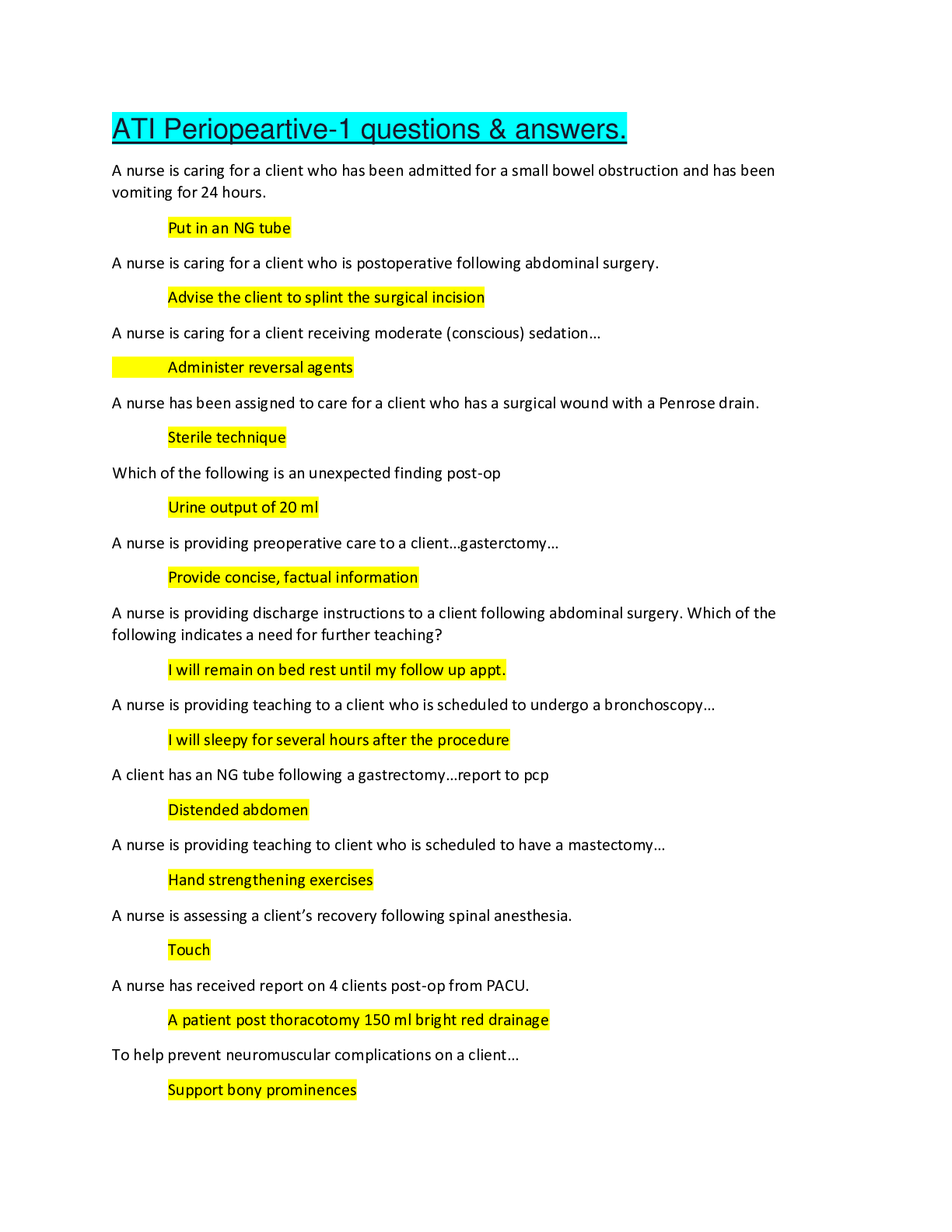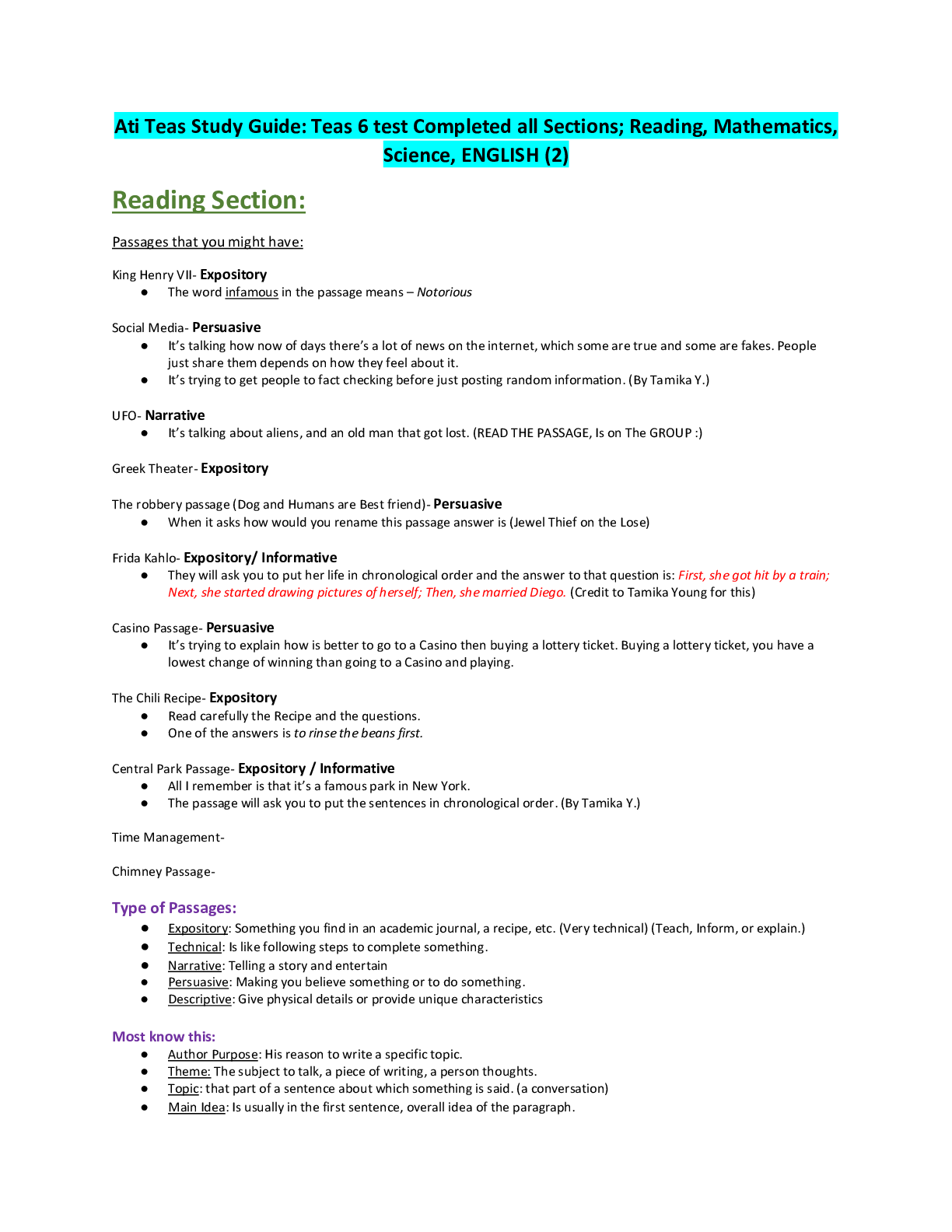*NURSING > QUESTIONS and ANSWERS > ATI MEDSURG FOCUSED REVIEW Hello (All)
ATI MEDSURG FOCUSED REVIEW Hello
Document Content and Description Below
ATI MEDSURG FOCUSED REVIEW Hello CHAPTER 4 Pain Management: Use of Nonpharmacologic Methods of Pain Relief (RN QSEN - Patient-centered Care, Active Learning Template - Basic Concept, RM AMS ... RN 10.0 Chp 4) CHAPTER 16 Spinal Cord Injury: Care of a Client who has a Halo Device (RN QSEN - Safety , Active Learning Template - Therapeutic Procedure, RM AMS RN 10.0 Chp 16) - CHAPTER 23 Tuberculosis: Priority Action for a Client in the Emergency Department (RN QSEN - Safety , Active Learning Template - System Disorder, RM AMS RN 10.0 Chp 23) CHAPTER 24 Pulmonary Embolism: Risk Factors for Deep-Vein Thrombosis (Active Learning Template - System Disorder, RM AMS RN 10.0 Chp 24) `` Electrocardiography and Dysrhythmia Monitoring: Analyzing ECG (Active Learning Template - Diagnostic Procedure, RM AMS RN 10.0 Chp 28) CHAPTER 36 Hypertension: Evaluating a Client Who Takes Lisinopril (RN QSEN - Safety , Active Learning Template - Medication, RM AMS RN 10.0 Chp 36) CHAPTER 40 Blood and Blood Product Transfusions: Treatment for Circulatory Overload (Active Learning Template - Therapeutic Procedure, RM AMS RN 10.0 Chp 40) CHAPTER 44 Electrolyte Imbalances: Effective Action of Magnesium Sulfate (Active Learning Template - Medication, RM AMS RN 10.0 Chp 44) • CHAPTER 47 Gastrointestinal Therapeutic Procedures: Total Parental Nutrition (RN QSEN - Safety , Active Learning Template - Therapeutic Procedure, RM AMS RN 10.0 Chp 47 CHAPTER 55 Pressure Ulcers, Wounds, and Wound Management: Implementing Preventive Strategies (RN QSEN - Safety , Active Learning Template - Basic Concept, RM FUND 9.0 Ch 55) CHAPTER 70 Osteoporosis: Teaching Self-Administration of Alendronate (RN QSEN - Safety , Active Learning Template - Medication, RM AMS RN 10.0 Chp 70) CHAPTER 71 Musculoskeletal Trauma: Maintaining Proper Traction (Active Learning Template - Therapeutic Procedure, RM AMS RN 10.0 Chp 71) CHAPTER 85 `BBBBBBBBBBBB` CHAPTER 93 Pain Management for Clients Who ATI MEDSURG FOCUSED REVIEW Hello CHAPTER 4 Pain Management: Use of Nonpharmacologic Methods of Pain Relief (RN QSEN - Patient-centered Care, Active Learning Template - Basic Concept, RM AMS RN 10.0 Chp 4) CHAPTER 16 Spinal Cord Injury: Care of a Client who has a Halo Device (RN QSEN - Safety , Active Learning Template - Therapeutic Procedure, RM AMS RN 10.0 Chp 16) - CHAPTER 23 Tuberculosis: Priority Action for a Client in the Emergency Department (RN QSEN - Safety , Active Learning Template - System Disorder, RM AMS RN 10.0 Chp 23) CHAPTER 24 Pulmonary Embolism: Risk Factors for Deep-Vein Thrombosis (Active Learning Template - System Disorder, RM AMS RN 10.0 Chp 24) `` Electrocardiography and Dysrhythmia Monitoring: Analyzing ECG (Active Learning Template - Diagnostic Procedure, RM AMS RN 10.0 Chp 28) CHAPTER 36 Hypertension: Evaluating a Client Who Takes Lisinopril (RN QSEN - Safety , Active Learning Template - Medication, RM AMS RN 10.0 Chp 36) CHAPTER 40 Blood and Blood Product Transfusions: Treatment for Circulatory Overload (Active Learning Template - Therapeutic Procedure, RM AMS RN 10.0 Chp 40) CHAPTER 44 Electrolyte Imbalances: Effective Action of Magnesium Sulfate (Active Learning Template - Medication, RM AMS RN 10.0 Chp 44) • CHAPTER 47 Gastrointestinal Therapeutic Procedures: Total Parental Nutrition (RN QSEN - Safety , Active Learning Template - Therapeutic Procedure, RM AMS RN 10.0 Chp 47 CHAPTER 55 Pressure Ulcers, Wounds, and Wound Management: Implementing Preventive Strategies (RN QSEN - Safety , Active Learning Template - Basic Concept, RM FUND 9.0 Ch 55) CHAPTER 70 Osteoporosis: Teaching Self-Administration of Alendronate (RN QSEN - Safety , Active Learning Template - Medication, RM AMS RN 10.0 Chp 70) CHAPTER 71 Musculoskeletal Trauma: Maintaining Proper Traction (Active Learning Template - Therapeutic Procedure, RM AMS RN 10.0 Chp 71) CHAPTER 85 `BBBBBBBBBBBB` CHAPTER 93 Pain Management for Clients Who Have Cancer: Managing Breakthrough Pain (Active Learning Template - System Disorder, RM AMS RN 10.0 Chp 93) CHAPTER 78 Hyperthyroidism: Assessing a Client for Chvostek's Sign Following a Thyroidectomy (Active Learning Template - Nursing Skill, RM AMS RN 10.0 Chp 78) CHAPTER 3 Neurologic Diagnostic Procedures: Preparing a Client for a Lumbar Puncture (Active Learning Template - Diagnostic Procedure, RM AMS RN 10.0 Chp 3) The risks versus benefits of a lumbar puncture should be discussed with the client prior to this procedure. DO NOT perform when patient has ICP or bleeding or on anticoagulant. NURSING ACTIONS: CHAPTER 45 Acid-Base Imbalances: Interpreting ABG Results (Active Learning Template - Diagnostic Procedure, RM AMS RN 10.0 Chp 45) CHAPTER 14 Head Injury: Monitoring Neurological Status (RN QSEN - Patient-centered Care, Active Learning Template - CHAPTER 80 Cushing's Disease/Syndrome: Priority Actions ( https://quizlet.com/50582148/mod-2-cushings-diseasesyndrome-ati-flash-cards/ CHAPTER 75 Burns: Assessment Findings of Early Phase of Injury (RN QSEN - Safety , Active Learning Template - Burns: Priority Action During Resuscitation Phase (RN QSEN - Safety, Active Learning Template - System Disorder, RM AMS RN 10.0 Chp 75) Emergent (Resuscitative Phase): CHAPTER 47 Gastrointestinal Therapeutic Procedures: Appropriate Actions for an Abdominal Paracentesis (RN QSEN - Safety , Active Learning Template - Therapeutic Procedure, RM AMS RN 10.0 Chp 47) Preprocedure • ) Intraprocedure CHAPTER 45 Sensory Perception: Performing Ear Irrigation (Active Learning Template - Nursing Skill, RM FUND 9.0 Ch 45) CHAPTER 15 Stroke: Planning to Administer Thrombolytic Therapy ( Medication: • . Catheter – directed thrombolytic therapy must be administered within 6 hr of the onset of symptoms CHAPTER 91 Cancer Treatment Options: Teaching About Skin Care Following Radiation Treatment (Active Learning Template - Therapeutic Procedure, RM AMS RN 10.0 Chp 91) • Inspect skin for evidence of damage and report to the provider. Cancer Treatment Options: Prioritizing Client Care (RN QSEN - Safety , Active Learning Template - Basic Concept, RM AMS RN 10.0 Chp 91) CHAPTER 18 Chest Tube Insertion and Monitoring: Clarifying Provider CHAPTER 14 Head Injury: Administering Medications for Increased Intracranial Pressure (Active Learning Template - System Disorder, RM AMS RN 10.0 Chp 14) CHAPTER 60 Infections of the Renal and Urinary System: Assessment of Flank Pain (Active Learning Template - CHAPTER 5 Meningitis: Planning Interventions for Care (Active Learning Template - System Disorder, RM AMS RN 10.0 Chp 5) CHAPTER 23 Tuberculosis: Discharge Teaching About Tuberculosis (Active Learning Template - System Diso) CHAPTER 43 Fluid Imbalances: Clinical Manifestations of Dehydration (Active Learning Template - System Disorder, 43 Chapter 59 Polycystic Kidney Disease, Acute Kidney Injury, and Chronic Kidney Disease: Findings to Report (Active Learning Template CHAPTER 28 Electrocardiography and Dysrhythmia Monitoring: Priority Action for Sinus Bradycardia (Active Learning Template - System Disorder,) CHAPTER 29 Pacemakers: Evaluating Client Understanding of Discharge Teaching (Active Learning Template - Therapeutic Procedure, RM AMS RN 10.0 Chp 29) CHAPTER 45 Acid-Base Imbalances: Evaluating Arterial Blood Gas Results (Active Learning Template - Basic Concept, CHAPTER 9 Brain Tumors: Pharmacological Treatment of Diabetes Insipidus (Active Learning Template - System Disorder, CHAPTER 86 HIV/AIDS: Priority Client Teaching (RN QSEN - Patient-centered Care, Active Learning Template - System Disorder, CHAPTER 25 Pneumothorax, Hemothorax, and Flail Chest: Interventions for Flail Chest (Active Learning Template - System Disorder, RM CHAPTER 78 Hyperthyroidism: Client Teaching About Thyroid Storm (RN QSEN - Patient-centered Care, Active Learning Template - System Disorder, RM AMS RN 10.0 Chp 78) ◯ Nursing Actions. ☐ Caution - If given before PTU, sodium iodide can exacerbate manifestations in susceptible clients. ■ ■ Administer supplemental O2 to meet increased oxygen demands. ◯ Client Education ■ CHAPTER 71 Musculoskeletal Trauma: Assessing for Compartment Syndrome (RN QSEN - Safety , Active Learning Template - CHAPTER 7 Parkinson¶s Disease: Teaching About Pathophysiology (Active Learning Template - System Disorder, RM 1. Identify three causes for hypokalemia 2. List three symptoms of hypokalemia List three nursing implications • 1. Identify three causes for hyperkalemia 2. List three symptoms of hyperkalemia • 3. List three nursing implications• A nurse is teaching a group of nursing students about the National Pressure Ulcer Advisory Panel’s classification system for pressure ulcers. RELATED CONTENT: List the six pressure ulcer stages along with a brief description of the assessment 1. SUSPECTED DEEP TISSUE INJURY:. 2. STAGE I: 3. STAGE II: 4. STAGE III: 5. STAGE IV: 6. UNSTAGEABLE: NURSING ACTIONS: List four nursing interventions to help prevent pressure ulcers. TREATMENT OPTIONS: List two treatment options for pressure ulcers RISK POTENTIAL: Discuss two indicators that increase a client’s risk for pressure ulcer A nurse is caring for a client who is receiving a blood transfusion. What nursing actions should the nurse anticipate if a transfusion reaction is suspected? • STOP THE INFUSION INDICATIONS • Describe the four types of reactions and the time of onset. 1. Acute Hemolytic transfusion reaction 2. Febrile, Non-hemolytic transfusion reaction: 3. Allergic reaction: 4. Transfusion-related acute lung injury (TRALI): T. 5. Circulatory Overload: • What are the primary differences between the four types of blood reactions? • What are the similarities? • For each type of blood reaction, name a medication that can be administered and explain why that medication would be given. Th POTENTIAL COMPLICATIONS: Describe one nursing actions for each type of reaction : What blood type is considered the universal donor and why? What blood type is considered the universal recipient and why? Are the answers to these questions the same for all blood products? Give an example of any differences if there are any. 1. Identify and discuss three risk factors that can result in heart failure. 2. Identify and discuss three types of medications that you might anticipate being prescribed for a client with heart failure. Discuss why these meds would be used. 3. Discuss atrial fibrillation. Include risks posted to the client when in atrial fibrillation. Name three medications this client would be taking and why. 4. Differentiate between right and left sided heart failure: Symptoms, assessment, pathophysiology, significance of identifying the differences. • Systolic failure SYMPTOMS OF HEART FAILURE INCLUDE: ASSESSMENT : Have Cancer: Managing Breakthrough Pain (Active Learning Template - System Disorder, RM AMS RN 10.0 Chp 93) CHAPTER 78 Hyperthyroidism: Assessing a Client for Chvostek's Sign Following a Thyroidectomy (Active Learning Template - Nursing Skill, RM AMS RN 10.0 Chp 78) CHAPTER 3 Neurologic Diagnostic Procedures: Preparing a Client for a Lumbar Puncture (Active Learning Template - Diagnostic Procedure, RM AMS RN 10.0 Chp 3) The risks versus benefits of a lumbar puncture should be discussed with the client prior to this procedure. DO NOT perform when patient has ICP or bleeding or on anticoagulant. NURSING ACTIONS: CHAPTER 45 Acid-Base Imbalances: Interpreting ABG Results (Active Learning Template - Diagnostic Procedure, RM AMS RN 10.0 Chp 45) CHAPTER 14 Head Injury: Monitoring Neurological Status (RN QSEN - Patient-centered Care, Active Learning Template - CHAPTER 80 Cushing's Disease/Syndrome: Priority Actions ( https://quizlet.com/50582148/mod-2-cushings-diseasesyndrome-ati-flash-cards/ CHAPTER 75 Burns: Assessment Findings of Early Phase of Injury (RN QSEN - Safety , Active Learning Template - Burns: Priority Action During Resuscitation Phase (RN QSEN - Safety, Active Learning Template - System Disorder, RM AMS RN 10.0 Chp 75) Emergent (Resuscitative Phase): CHAPTER 47 Gastrointestinal Therapeutic Procedures: Appropriate Actions for an Abdominal Paracentesis (RN QSEN - Safety , Active Learning Template - Therapeutic Procedure, RM AMS RN 10.0 Chp 47) Preprocedure • ) Intraprocedure CHAPTER 45 Sensory Perception: Performing Ear Irrigation (Active Learning Template - Nursing Skill, RM FUND 9.0 Ch 45) CHAPTER 15 Stroke: Planning to Administer Thrombolytic Therapy ( Medication: • . Catheter – directed thrombolytic therapy must be administered within 6 hr of the onset of symptoms CHAPTER 91 Cancer Treatment Options: Teaching About Skin Care Following Radiation Treatment (Active Learning Template - Therapeutic Procedure, RM AMS RN 10.0 Chp 91) • Inspect skin for evidence of damage and report to the provider. Cancer Treatment Options: Prioritizing Client Care (RN QSEN - Safety , Active Learning Template - Basic Concept, RM AMS RN 10.0 Chp 91) CHAPTER 18 Chest Tube Insertion and Monitoring: Clarifying Provider CHAPTER 14 Head Injury: Administering Medications for Increased Intracranial Pressure (Active Learning Template - System Disorder, RM AMS RN 10.0 Chp 14) CHAPTER 60 Infections of the Renal and Urinary System: Assessment of Flank Pain (Active Learning Template - CHAPTER 5 Meningitis: Planning Interventions for Care (Active Learning Template - System Disorder, RM AMS RN 10.0 Chp 5) CHAPTER 23 Tuberculosis: Discharge Teaching About Tuberculosis (Active Learning Template - System Diso) CHAPTER 43 Fluid Imbalances: Clinical Manifestations of Dehydration (Active Learning Template - System Disorder, 43 Chapter 59 Polycystic Kidney Disease, Acute Kidney Injury, and Chronic Kidney Disease: Findings to Report (Active Learning Template CHAPTER 28 Electrocardiography and Dysrhythmia Monitoring: Priority Action for Sinus Bradycardia (Active Learning Template - System Disorder,) CHAPTER 29 Pacemakers: Evaluating Client Understanding of Discharge Teaching (Active Learning Template - Therapeutic Procedure, RM AMS RN 10.0 Chp 29) CHAPTER 45 Acid-Base Imbalances: Evaluating Arterial Blood Gas Results (Active Learning Template - Basic Concept, CHAPTER 9 Brain Tumors: Pharmacological Treatment of Diabetes Insipidus (Active Learning Template - System Disorder, CHAPTER 86 HIV/AIDS: Priority Client Teaching (RN QSEN - Patient-centered Care, Active Learning Template - System Disorder, CHAPTER 25 Pneumothorax, Hemothorax, and Flail Chest: Interventions for Flail Chest (Active Learning Template - System Disorder, RM CHAPTER 78 Hyperthyroidism: Client Teaching About Thyroid Storm (RN QSEN - Patient-centered Care, Active Learning Template - System Disorder, RM AMS RN 10.0 Chp 78) ◯ Nursing Actions. ☐ Caution - If given before PTU, sodium iodide can exacerbate manifestations in susceptible clients. ■ ■ Administer supplemental O2 to meet increased oxygen demands. ◯ Client Education ■ CHAPTER 71 Musculoskeletal Trauma: Assessing for Compartment Syndrome (RN QSEN - Safety , Active Learning Template - CHAPTER 7 Parkinson¶s Disease: Teaching About Pathophysiology (Active Learning Template - System Disorder, RM 1. Identify three causes for hypokalemia 2. List three symptoms of hypokalemia List three nursing implications • 1. Identify three causes for hyperkalemia 2. List three symptoms of hyperkalemia • 3. List three nursing implications• A nurse is teaching a group of nursing students about the National Pressure Ulcer Advisory Panel’s classification system for pressure ulcers. RELATED CONTENT: List the six pressure ulcer stages along with a brief description of the assessment 1. SUSPECTED DEEP TISSUE INJURY:. 2. STAGE I: 3. STAGE II: 4. STAGE III: 5. STAGE IV: 6. UNSTAGEABLE: NURSING ACTIONS: List four nursing interventions to help prevent pressure ulcers. TREATMENT OPTIONS: List two treatment options for pressure ulcers RISK POTENTIAL: Discuss two indicators that increase a client’s risk for pressure ulcer A nurse is caring for a client who is receiving a blood transfusion. What nursing actions should the nurse anticipate if a transfusion reaction is suspected? • STOP THE INFUSION INDICATIONS • Describe the four types of reactions and the time of onset. 1. Acute Hemolytic transfusion reaction 2. Febrile, Non-hemolytic transfusion reaction: 3. Allergic reaction: 4. Transfusion-related acute lung injury (TRALI): T. 5. Circulatory Overload: • What are the primary differences between the four types of blood reactions? • What are the similarities? • For each type of blood reaction, name a medication that can be administered and explain why that medication would be given. Th POTENTIAL COMPLICATIONS: Describe one nursing actions for each type of reaction : What blood type is considered the universal donor and why? What blood type is considered the universal recipient and why? Are the answers to these questions the same for all blood products? Give an example of any differences if there are any. 1. Identify and discuss three risk factors that can result in heart failure. 2. Identify and discuss three types of medications that you might anticipate being prescribed for a client with heart failure. Discuss why these meds would be used. 3. Discuss atrial fibrillation. Include risks posted to the client when in atrial fibrillation. Name three medications this client would be taking and why. 4. Differentiate between right and left sided heart failure: Symptoms, assessment, pathophysiology, significance of identifying the differences. • Systolic failure SYMPTOMS OF HEART FAILURE INCLUDE: ASSESSMENT : [Show More]
Last updated: 2 years ago
Preview 1 out of 21 pages

Buy this document to get the full access instantly
Instant Download Access after purchase
Buy NowInstant download
We Accept:

Reviews( 0 )
$14.00
Can't find what you want? Try our AI powered Search
Document information
Connected school, study & course
About the document
Uploaded On
Jan 05, 2021
Number of pages
21
Written in
Additional information
This document has been written for:
Uploaded
Jan 05, 2021
Downloads
0
Views
97










.png)



